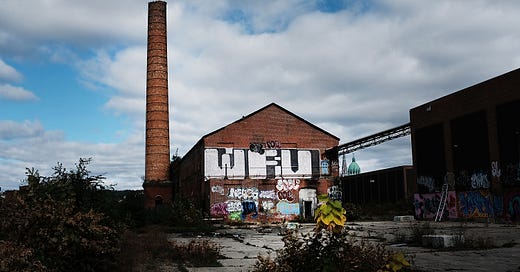
The economist Dani Rodrik likes to tell the story of the time he sent a draft of his 1997 book, Has Globalization Gone Too Far?, to a “well known and outspoken economist” for review:
He told me he had no quarrel with my economics, but that I should not be “providing ammunition to the barbarians”—that is, I should not give comfort to all those protectionists who stand ready to hijack any argument that seems to provide intellectual respectability to their positions.`
The economist in question was Paul Krugman, as Rodrik quietly revealed in the footnotes of a later book. The irony, of course, is that Krugman went on to coin the sarcastic epithet “Very Serious People” to describe precisely this tendency of elites to argue in bad faith. Deficits and inflation aren’t always bad, for example, but Very Serious People resist deviating from hawkish views lest spendthrift politicians run free. The late-1990s Krugman was evidently himself a Very Serious Person who understood economic globalization to be, while not costless, far too important to risk confusing the public with subtlety.
Maybe Krugman had a point. Rodrik’s book was published only a few years after the deadly, NAFTA-inspired peasant rebellion in south west Mexico, and a few years before the hysterical WTO protests in Seattle. And today, animus against globalization and free trade has found its way into the Oval Office, where at various points NAFTA and the World Trade Organization have come close to being smashed in much the same way Seattle black bloc rioters smashed Starbucks windows in 1999.
To Rodrik’s credit, he “agonized endlessly” over whether he might be doing the wrong thing, but in the end decided that an economist’s job is to explain the evidence, not engage in strategic discourse. In his case, Rodrik remains persuaded by the evidence suggesting rapid economic integration poses risks to social cohesion and perceived democratic legitimacy, particularly when governments do too little to communicate and redress its very real costs. The biggest upheavals of past decade — Brexit, the Euro crisis, the election of Donald Trump — only reinforce his prescience.
I’ve reached a similar conclusion. Barbarians to the left of me, barbarians to my right. Here I am, stuck with a nuanced view.
The Irrelevance of Utilitarian Calculus
The complexity is that neither I nor Rodrik oppose globalization, per se. On the contrary, globalization has been the greatest force for peace and poverty alleviation history has ever known. It’s because the benefits of interdependence are so large that one must take seriously, and speak frankly, about the background political economy necessary for sustaining the global economic order for the long run.
It’s in this context that I read Scott Lincicome’s sweeping, 5,500 word rebuttal to my and W. Bradford Wilcox’s recent piece in The Atlantic defending Tucker Carlson’s now-infamous monologue. For those who haven’t kept track, Carlson argued, in essence, that many of the ills affecting the rural working class — from family instability to falling wages and deaths of despair — are partly attributable to elite policy decisions, particularly the decision to liberalize trade with China.
In our piece, we pointed to empirical research from the economists Autor, Dorn and Hanson (ADH) suggesting the labor market large shock following China’s entry into the WTO in 2001 caused a precipitous decline in U.S. manufacturing employment that harmed the earnings, family formation, and health of working class men. Yet rather than blame trade, we pointed a finger at “a laissez-faire ideology that sees labor markets as automatically self-correcting,” and the underinvestment in the forms of social insurance and trade adjustment policy that cushion economic shocks and help transition workers into new forms of skilled employment.
Lincicome agrees with our “larger points, having myself written about the serious, and relatively new, problems that Americans face when forced to adjust to severe disruptions.” Nonetheless, he worries that our arguments would “find ample company on the right, including in the Trump administration” — that is, provide ammunition to the present-day barbarians.
As a result, Lincicome spends the preponderance of his essay recapitulating the massive benefits of trade and downplaying its cost. Chinese import competition between 2000-07, for example, “had substantial ‘pro-competitive effects’ on U.S. firms and generated over $202 billion in consumer benefits via lower prices—equal to $101,250 per manufacturing job lost, as calculated by the China Shock papers.”
Yet this was never in dispute, and if anything feeds directly into the “elitism” critique leveled by Carlson and company. Studies that try to weigh the concentrated cost of a community’s main employer being shuttered against the diffuse consumer benefits of cheaper imports aren’t useless, but in context amount to the economist’s version of let them eat cake: “Let them eat utils.” For the affected workers and their families, such arguments are worse than false comfort. They’re enraging.
Dangerous Facts or Dangerous Denials?
While I’m personally skeptical of our ability to integrate costs and benefits across the experiences of diverse communities, perhaps public policy should be guided by such utilitarian calculuses. The deeper question, however, is political. When we fail to have an honest conversation about trade’s costs, either in the present or as a matter of history, what ought to be a practical policy debate devolves into a referendum on the value of free trade itself. This, I believe, is what Lincicome and I both wish to avoid.
The tension between speaking frankly and strategically is an ancient one. As Plato expressed in the Seventh Letter, if deep philosophical truths “could adequately be put down in writing for the many” it might benefit a few worthy minds, but, “of the rest, it would unsuitably fill some of them with a mistaken contempt, and others with a lofty and empty hope as if they had learned awesome matters.”
From Plato on, the impulse to relegate potentially dangerous truths to a select minority has been the sine qua non of elitism. Whatever its historical merits, the value of elite esotericism is breaking down in the age of the internet.
As Steven Pinker recently argued with respect to the rise of the Alt-Right, suppressing open discussion of “dangerous facts” often backfires spectacularly. In this case, Pinker argued that the politically correct denial of group and sex differences, rather than reduce ammunition for racist and sexist views, leaves the barbarians as the only ones who seemed to grok reality when college-going men invariably begin questioning the doctrine of social constructivism. Without a healthy middle ground, the realization that they are misled destroys their faith in academic authority and pulls them to the most extreme and unsavory interpretations of the data.
A similar tendency is seen in many other debates. Just as free market economists are pressured to idealize the benefits of globalization, climate scientists are pressured to catastrophize the costs of global warming. In both realms, the damage to the authority of genuine, honest experts has been immeasurable.
Thus before returning to the question of whether our scorn for “elites” is warranted, I wish to review the evidence behind what Lincicome dubs the “PNTR thesis,” namely my view that the extension of “permanent normal trade relations” with China produced real and asymmetric costs for many blue collar workers. If authority in the pro-trade elite is to be salvaged, a honest reckoning with recent history is an essential first step.
The PNTR Thesis Revisited
On October 10, 2000, the United States congress voted to make our “normal trade relations” with the People’s Republic of China permanent, rather than an agreement that had been renewed annually since 1980. This paved the way for China’s membership in the WTO one year later.
PNTR wasn’t such a big deal, according to Lincicome, because:
Chinese imports to the United States increased more than six-fold in the decade preceding PNTR, and the rational expectation of most U.S. importers was more of the same. Chinese imports increased even more after PNTR, likely assisted by the certainty of “permanent” trade relations, but it’s a myth to say that some isolated, “elite” policy choice in the late 1990s first exposed the U.S. market (and U.S. workers) to Chinese import competition.
That is certainly a myth, but also not something anyone seriously argues. The argument has always been that PNTR was unique. As economists Justin R. Pierce and Peter K. Schott write in their 2015 paper, The Surprisingly Swift Decline of U.S. Manufacturing Employment,
Media reports, Congressional testimony and government reports make clear that firms viewed renewal of China's NTR status as uncertain, and that this uncertainty suppressed investment needed to source goods from China.
In particular, while the low tariffs provided by NTR status allowed the growth of many imports to the U.S., without the certainty of a permanent relationship American companies were much less likely to “incur the sunk costs associated with shifting operations to China or establishing a relationship with an existing Chinese producer.” When that uncertainty lifted, U.S. firms reorganized their production chains and Chinese manufacturers ramped up exports in a way that induced a sudden and unprecedented drop in U.S. manufacturing employment. Pierce and Schott confirm this interpretation by comparing U.S. job losses to the relatively smaller losses in the EU, which has had PNTR with China since 1980.
While Lincicome embeds a link to Pierce and Schott’s paper, he downplays their findings with a chart showing a slow and stable decline in manufacturing employment as a share of total non-farm payrolls. This is misleading, however, as it conceals the swift drop in the level of manufacturing employment behind an even faster growing national economy. Turn to the employment level, and one sees that the number of Americans working in manufacturing was remarkably stable, hovering around 18 million from 1965 to 2000, including throughout the 1990s, before plunging 18 percent between March 2001 to March 2007. The change in levels, not proportions, is what matters most from a trade adjustment perspective.

While estimates vary, few dispute that PNTR with China was the driving factor behind U.S. manufacturing employment losses in the 2000s. ADH’s seminal 2013 paper attributes 55 percent of the decline in U.S. manufacturing employment between 2000 and 2007 to Chinese import competition. Subsequent research has derived similar estimates with different or improved methodologies, although Lincicome chooses to describe these findings in a way that is inherently minimizing. For example, a WTO study Lincicome cites favorably argues ADH’s use of gross import values, rather than value added, “overstate[s] the direct impact of Chinese imports on US manufacturing jobs by 32.3%.” Yet they reach this conclusion by first finding (in a modified specification) that gross imports explain 59.8% of manufacturing job losses between 2000 and 2007, compared to 45.2% when value added imports are used. The difference between these two estimates does suggest the original ADH estimate is overstated, but it also confirms, as the authors put it, that the “qualitative conclusions of ADH are robust.”
The rosiest paper Lincicome cites uses a “dynamic general equilibrium” approach that tries to model both the China Shock and labor market adjustment that followed. Whereas ADH argue for a manufacturing employment loss of one to two million, accounting for workers who eventually transition pulls the permanent manufacturing job loss down to 550,000 over a 15-year period, or “36% of the change in manufacturing employment that is not explained by a secular trend.” Needless to say, a lot of painful adjustment can happen over a 15-year stretch. A general equilibrium framework, while useful for understanding the long run, is somewhat less relevant for understanding the bleeding edge of a sudden shock.
The moral of the story is that different models make different assumptions and in turn measure different things. The major takeaway from Lincicome’s literature review is therefore not that estimates of the China Shock’s effect on manufacturing employment vary, but that multiple different modeling approaches arrive at the same qualitative conclusion: PNTR with China had a large and permanent effect on U.S. manufacturing employment with costs and benefits that, while likely positive on net, imposed large, sudden, and concentrated costs.
The China Shock’s Non-Monetary Cost
The costs of the China Shock were particularly large for non-college- educated men in rural regions. Non-metropolitan labor markets — the types supported by a lone furniture factory or equipment manufacturer — are particularly vulnerable to trade shocks, and for obvious reasons. While much has been made of the fact that the losers from PNTR were predominantly less educated whites, this is a byproduct of geographical and educational sorting. Far from advancing racial justice, such framings merely provide fodder for chauvinists.
So what were the costs? Lower earnings and reduced labor force participation were among the first order effects, however ADH argue that acute economic distress translated into non-monetary costs as well, including falling marriage rates and increased mortality. Lincicome’s rebuttal to this component of the argument consists of three links — two skeptical econ-bloggers and one tweet advising against putting too much weight on a single study. While I have no doubts about each source’s respective expertise, none provide a serious rebuttal of ADH’s findings.
As Lincicome goes on to note, ADH make no claim that the China Shock was the “sole or primary driver of these trends,” and neither do I. The point is that their findings are significant and substantial. In commuting zones that experienced a one percentage point increase in Chinese import penetration between 1990 and 2014, ADH find a reduction in the male-female annual earnings advantage of “3.3 percent at the median and by nearly 9.5 percent at the 25th percentile.” In commuting zones where the trade shock primarily affected male-intensive industries, the percentage of young married women decreased by about 3.5 percentage points on average; never married women increased by over 4 percentage points; and births fell by 7.9 per thousand.
While women’s preference for marrying higher earning men is a large factor in these trends, it’s sadly not the only one. As ADH further find, a 1one percentage point increase in Chinese import penetration over the same time period “raises the relative male death rate from drug and alcohol poisoning by more than 50 percent.” In other words, a “non-negligible” part of the marriage decline in regions exposed to Chinese import competition is also explained by the premature death of marriageable men.
To be sure, we should be cautious about drawing conclusions from a single study. But it’s not the only study. In a 2016 paper, Peirce and Schott use data from the U.S. Centers for Disease Control to examine whether counties exposed to PNTR experience differential changes in mortality. Their findings are worth quoting at length:
We find that PNTR is associated with a statistically significant relative increase in suicide, and that this result is robust to inclusion of county-level demographic and economic control variables. Coefficient estimates imply that an interquartile shift in counties' NTR gap is associated with an increase in the annual suicide rate of 4.0 percent relative to its respective average in the year 2000, the year of the change in U.S. trade policy. Across age and racial groups, we find that the relationship between PNTR and suicide is concentrated among white males. We also find that PNTR is associated with statistically significant relative increases in mortality from accidental poisoning, though those estimates are more sensitive to the set of county attributes included in the regression and to its specification.
Connecting mortality to labor market outcomes, Peirce and Schott then test county mortality rates on county unemployment rates, using PNTR exposure as an instrument:
The resulting coefficient estimates suggest that a 1 standard deviation increase in the unemployment rate (2.6 percentage points) is associated with a 29.1 percent increase in the suicide rate. This elasticity is approximately an order of magnitude greater than that estimated in Ruhm (2000), which finds that a 1 standard deviation increase in the state unemployment rate (2.1 percentage points) is associated with a 2.7 percent increase in the suicide rate.
This last finding is particular ugly for the fatuous argument that a million or so jobs lost to a trade shock can’t be so bad when millions of jobs are created and destroyed every quarter through normal economic churn. A town that loses its main employer, shunting dozens of workers into lower paying jobs, public assistance or worse, has qualitatively different implications than a similar number of firings spread across a $20 trillion economy. Go figure.
The Political Economy of Trade Shocks
Understanding the China Shock’s political ramifications is also important, especially for defenders of globalization. Using location-code applications for Trade Adjustment Assistance, new research finds that exposure to recent trade shocks increased negative views on trade and U.S. global leadership, and predicted an increase vote share for Donald Trump in the 2016 presidential election.
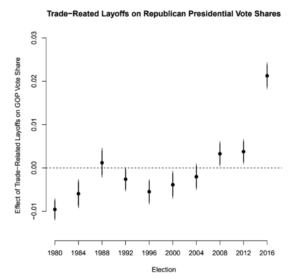
The effect is seen at the congressional level, too. As another study finds,
The liberalization of trade following China's accession to the World Trade Organization increased political polarization among American voters and encouraged legislators in economically hard-hit districts to take positions hostile to China. The result is that Congress is even more hostile towards China today than in the aftermath of the Tiananmen Massacre. After 2003, members of Congress representing districts more adversely impacted by import competition were more likely to vote against China, controlling for ideology and partisanship.
Complicating the usual “economics versus culture” debate, the effects of trade shocks appear to shift public opinion across entire regions and across a variety of issues, including towards more nativist views on immigration. Researchers have described this effect as “trade-induced cultural backlash.” In their own paper, ADH argue increased trade exposure “imports political polarization,” and predicts the removal of moderates from congressional offices in both parties.
Granted, these findings do nothing to discount the aggregate welfare benefits of PNTR, nor build a case for its reversal — at risk of repeating myself, this was never the point. On the contrary, most of the adjustment to the China Shock is already baked in. Suddenly ending PNTR would risk creating an analogous labor market shock in reverse. The point is simply to allay one-sided narratives and invite some symmetry (and sympathy) to the debate.
That’s important for accuracy's sake, but also because casually dismissing the cost side only makes the cynicism of those who witnessed the trade shock first hand grow stronger. In grappling with the practical realities of PNTR’s effect on American manufacturing, the well-being of the rural working class, and the political economy of nativism, evangelists have nothing to contribute.
The Choice
Lincicome’s final major point is to argue that PNTR wasn’t a policy choice, but the natural and anticipated conclusion to a liberalization process that was already well underway. “Thus, from a simple legal and historical perspective,” he writes, “there was nothing ‘shocking’ about the China Shock.”
Let’s set aside the fact that the “Shock” in “China Shock” refers to the “surprisingly swift” effects it had on U.S. manufacturing employment and other social indicators, not the legislative expectations of the D.C. policy establishment. Nevertheless, the notion that PNTR was seen as inevitable is directly challenged by the “uncertainty index” developed by Pierce and Schott. Whatever the personal expectations of Lincicome and his colleagues in the late 1990s, the companies and investors with skin in the game were unwilling to place bets on PNTR until it actually became law.
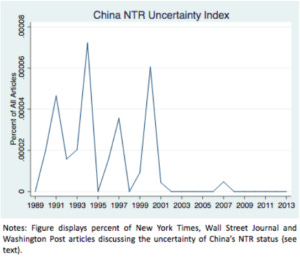
If PNTR was truly inevitable, rather than the contingent and uncertain decision of the U.S. Congress and pPresident, the economic data discussed above are even harder to explain. As Lincicome’s own retelling details, U.S. negotiations with China were extremely contentious and drawn-out. And while the principle alternative — maintaining NTR while leaving China out of the WTO — was in Lincicome’s estimation undesirable, that is merely a restatement of his policy preference, not evidence against the viability of a counterfactual nor the ability for Congress to make a different choice. The U.S.’s (admittedly misguided) decision to pull out of the Trans Pacific Partnership after leading the negotiation for years is a case in point.
What about the well-being of Chinese workers who benefited from the subsequent export boom? As a self-identified globalist, I fully agree that their welfare matters. Yet the relevant alternative was never “no trade,” but trade of different terms. For an economy the size of China, access to the U.S. market remains one of strongest sources of leverage the world has to promote their continued internal liberalization. Reihan Salam has even argued that PNTR may end up hurting the freedoms and living standards of the Chinese in the long run:
What might the world have looked like had the U.S. never granted PNTR to China? One possibility is that China would have pursued an economic strategy built around fostering indigenous entrepreneurship and bettering the lives of its own workers, as it did in the 1980s. Instead, Beijing chose to transfer wealth from ordinary Chinese citizens to its politically powerful export sector, a path made possible by PNTR. China might very well have become just as rich by embracing a more balanced and humane approach to development. Doing so, however, would have required that its central government surrender a measure of control to its citizens. Rather than foster liberalism and openness in China, I suspect PNTR did exactly the opposite—creating the conditions for China’s central government to exert tighter control over the Chinese populace.
There is no good way of assessing the plausibility of this counterfactual. The debate, at this point, is academic. Nonetheless, the centralization of power under Xi Jinping, and the evidence that China’s state-managed economy is driving itself into a middle-income trap, cries out for keeping an open mind.
Learning to Adjust
If the point isn’t to reverse PNTR, what is the point? Lincicome puts it well:
...casting the China Shock as a trade problem and not an adjustment problem, and claiming an ignorant or heartless “elite” absence of government interventions, has the potential to forgive the real and important failures of our policymakers, CEOs and union heads over the last two decades, while empowering those with far-less-legitimate or altruistic objectives, and thus make generating a political consensus for real policy solutions even harder.
Not only do I heartily agree with part in bold, it echoes a line I’ve often used myself, most recently in a joint paper with my Niskanen Center colleagues this December:
Rather than seeing the China shock as a failure of trade policy, we ought to see it as an indictment of our inadequate social insurance system and the small-government ideology that left us unawares.
Where I part company is in Lincicome’s somewhat paradoxical assertion that we should avoid blaming “elites,” lest we forgive the failures of our “policymakers, CEOs and union heads.” In fact, those are very much the “elites” I have in mind, a list to which I’d add many right-leaning free trade advocates who, for ideological reasons, dramatically underestimated the need for adjustment policies at the time.
To give just one illustrative example, flashback to May 2000, at the apotheosis of the PNTR debate. The left-wing Economic Policy Institute (EPI) had just issued a briefing warning that the agreement would cause the U.S. trade deficit with China to “increase by at least 80% between 1999 and 2010, resulting in the elimination of 872,091 jobs during the next decade,” and that “the largest effects of China’s accession to the WTO will be felt in the manufacturing…”. The libertarian Cato Institute, the homebase for much of Lincicome’s current work, was unimpressed. Cato’s director of Trade Policy at the time, the estimable Daniel Griswold, penned the following commentary excoriating EPI’s report:
These alarmist predictions about job losses caused by expanding trade are based on flawed economic reasoning and invariably conflict with empirical evidence. In reality, much of what we import from China, such as toys, shoes, and clothing, substitutes for imports from other low-wage producers. … Second, EPI assumes that passage of PNTR will entice U.S. companies to relocate en masse to China—that “giant sucking sound” again, this time over the Pacific. But if U.S. companies gain greater access to the Chinese market through PNTR, they will be better able to export to China from U.S. plants rather than be forced to build plants in China to gain access.
As we now know, the U.S. trade deficit with China more than doubled in the decade after PNTR, and with manufacturing job losses that put EPI’s forecast at the low end of estimates. Many multinationals did relocate, and while U.S. manufacturing output increased in value-added terms, the boom was driven by a single high-value added sector — semiconductors. Meanwhile, the manufacturing jobs that were lost were largely replaced by lower paying jobs in the service sector and in careers that demanded much high levels of education.
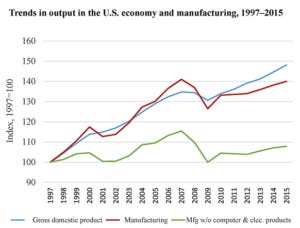
Acknowledging that trade critics got something right does not imply support for protectionism. But it does call for introspection into which aspects of one’s model of the world were wrong and need updating. Nonetheless, to this day, the more “laissez-faire” voices in the Washington policy establishment continue to argue against adequately funding trade adjustment and redistribution of all types — sometimes merely on the grounds that to do so would be a tacit admission that trade has costs!
As Rodrik, myself, and many others have argued, the small open economies of Europe acquired their comprehensive welfare states not by accident, but because their size relative to the global market — and thus exposure to international trade shocks — increased the democratic demand for strong income and re-employment supports. Programs like Trade Adjustment Assistance (TAA), in contrast, are so ineffectual because they are narrow and post-hoc. In this sense, Cato’s Daniel Griswold has a point when he writes,
On principle, there is no reason why workers displaced by trade should receive any special benefits. Why are they any more deserving than workers laid off by Blockbuster, Borders, Bank of America or the latest daily newspaper to close its doors?
Indeed, from the point of view of economic security, there is no principled distinction between a trade shock, a technology shock, or a negative demand shock. But that’s all the more reason to craft employment supports that are truly comprehensive, if only to provide a path of least resistance away from other programs with other purposes. In the U.S. commuting zones most exposed to the China Shock, for example, Social Security Disability Insurance was more than 30 times more responsive to worker dislocation than TAA and Unemployment Insurance combined.
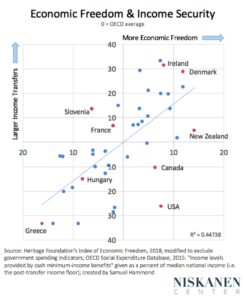
The more an economy opens itself to trade and innovation, the more the resulting volatility will necessitate social insurance systems to be in place concurrent with the liberalization process. Adjustment policies cannot be something that we simply promise to get to later. By then, disgruntled voters are primed for a more reactionary response. This helps to explain why modern economies tend to fall along a spectrum linking economic freedom to social spending. Each end of the spectrum reflects a different approach to meeting the populist demand for economic security in volatile world — regulated stagnation versus insured dynamism. The United States, as an outlier, sits at a crossroad.
As Rodrik wrote in the final chapter of Has Globalization Gone Too Far,
Hence economists could play a much more constructive role if they were to recognize that the tensions between social stability and globalization are real. They could help develop the conceptual frameworks needed for rethinking the roles of governments and of international institutions in this new phase of the global economy. They could assist policy makers in finding the tools and instruments needed to achieve policy objectives rather than taking issue with the objectives or denying that the problems exist.
The beginning of the 21st century is the story of America’s rocky transition from a large, closed economy to a comparatively small and open one, bringing all the policy dilemmas smaller countries faced long before us. The implication is clear. Either defenders of globalization confront its cost with clear eyes, or the barbarians will for us.


